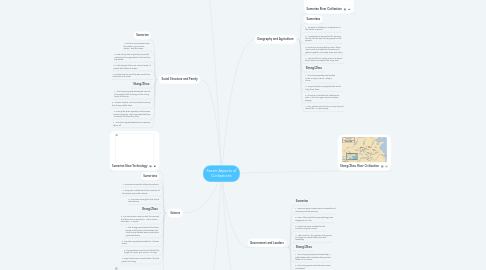Seven Aspects of Civilizations
作者:Rachel Coughlin

1. Religion
1.1. Sumerian Religious Artifact
1.2. Sumerians
1.3. 1. Sumerians are polytheistic, which means they believe in more than one god.
1.4. 2. They have many goddesses. For example, each city-state had a goddess.
1.5. 3. Each city of Sumerians had a temple house.
1.6. 4. Humans were believed to be created by the God Enki.
1.7. Shang/Zhou
1.8. 1. Shang kings saw the universe filled with real ghosts and spirits of good and evil.
1.9. 2. The 4 highest priests of Zhou period were prayers, sacrifices, deities and astrologers.
1.10. 3. The Zhou three realms of deities are heavenly spirits, terrestrial forces, and human ancestors.
1.11. 4. People worshiped many gods during the Shang Dynsasty meaning they were polytheistic.
1.12. Shang/Zhou Religious Artifact
2. Arts and Education
2.1. Sumerian Art
2.2. Sumerians
2.3. 1. Sumerians used clay for their art but it was difficult to make sharp edges.
2.4. 2. They started to use stone but still kept the round effect.
2.5. 3. Sumerians created the first known education system. (schools)
2.6. 4. Most education occurred in a temple with a priest present.
2.7. Shang/Zhou
2.8. 1. At the time, Shang writing was mostly pictographic.
2.9. 2. Pottery and ceramics were an important part of Shang handicraft industry.
2.10. 3. During the Shang Dynasty, inscriptions on bones and tortoise shells were simple records of teaching and learning.
2.11. 4. Nobles built schools to teach their children in the Western Zhou Dynasty.
2.12. Shang/Zhou Art
3. Science
3.1. Sumerian New Technology
3.2. Sumerians
3.3. 1. Sumerians invented military formations.
3.4. 2. They were credited with the invention of the wheel and potters wheel.
3.5. 3. They were among the first formal astronomers.
3.6. Shang/Zhou
3.7. 4. The Sumerians came up with the concept that there are 60 minutes in 1 hour and 60 seconds in 1 minute.
3.8. 1. The Shang period was the first time bronze casting was industrialized and ritual bronze vessels were produced in royal workshops.
3.9. 2. The Zhou Dynasty inherited the Chinese script.
3.10. 3. Shang astronomers found out that the length of a solar year as 365 1/4 days.
3.11. 4. Royal tombs were constructed in the last period of Shang.
3.12. Shang/Zhou New Technology
4. Social Structure and Family
4.1. Sumerian
4.2. 1. The four social classes were the nobles, commoners, clients , and the slaves.
4.3. 2. Each family had a cylindrical seal with meaning and images which acted as their signatures.
4.4. 3. In the temple, there are various levels of priests with different duties.
4.5. 4. Families lived in small houses made from clay bricks and reeds.
4.6. Shang/Zhou
4.7. 1. The Shang Dynasty developed a social class system with the king and his ruling family at the top.
4.8. 2. Artisans, traders, and merchants made up the Shang middle class.
4.9. 3. During the Zhou Dynasty, Confucianism became popular. The kings expected their to citizens to follow the rules.
4.10. 4. The Zhou Dynasty believed in emperors above all.
5. Shang/Zhou River Civilization
6. Geography and Agriculture
6.1. Sumerian River Civilization
6.2. Sumerians
6.3. 1. Sumeria is located in Mesopotamia in the Fertile Crescent.
6.4. 2. Mesopotamia was perfect for farming but the climate was not very good for the people.
6.5. 3. Sumeria is surrounded by rivers, these rivers made it possible for Sumerians to gather together and make farms and cities.
6.6. 4. The land that is not by rivers is a desert, which does not support the crops well.
6.7. Shang/Zhou
6.8. 1. The Shang Dynasty was located in the Huang He River Valley in China.
6.9. 2. They had water and good fertile soil to help them there.
6.10. 3. The Zhou controlled the Yellow River plain. Also, the region around modern Beijing.
6.11. 4. The Western part of China is very dry and desert-like. It is also windy.
7. Government and Leaders
7.1. Sumerian
7.2. 1. Sumerian government was a combination of monarchy and democracy.
7.3. 2. One of the most famous priest-kings was Gilgamesh of Uruk.
7.4. 3. Sumerians were credited for the invention of government.
7.5. 4. After 3000 b.c, the position of king was no longer an elected office but was hereditary.
7.6. Shang/Zhou
7.7. 1. The Shang dynasty was founded by a rebel leader, who overthrew the previous leader of Xia China.
7.8. 2. The Shang government became more centralized.
7.9. 3. The Zhou dynasty had a very large military and was very powerful.
7.10. 4. The zhou dynasty was founded by King Wen of the Ji family.
8. Economy and Trade
8.1. Sumerian
8.2. 1. The Sumerian economy was based on agriculture.
8.3. 2. One of their greatest innovations was the wheel. Which was invented for carts, chariots, and pottery making.
8.4. 3. Sumerian homes were huts made out of bundles of reeds, and then built from sun- baked mud bricks since there was limited stone.
8.5. 4. The Sumerians used slaves. Slave women worked as weavers and pressers.
8.6. Shang/Zhou
8.7. 1. Shang dynasty economy was based on agriculture.
8.8. 2. The shang dynasty used trade routs to connect with faraway lands.
8.9. 3. The Shang farmers were also known as peasants and there fields were owned by nobles.
8.10. 4. Slaves were used to provide labor.


